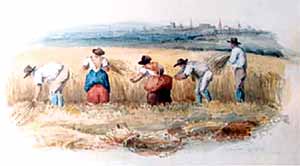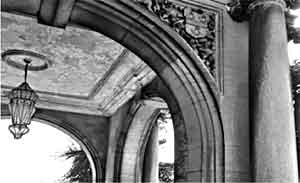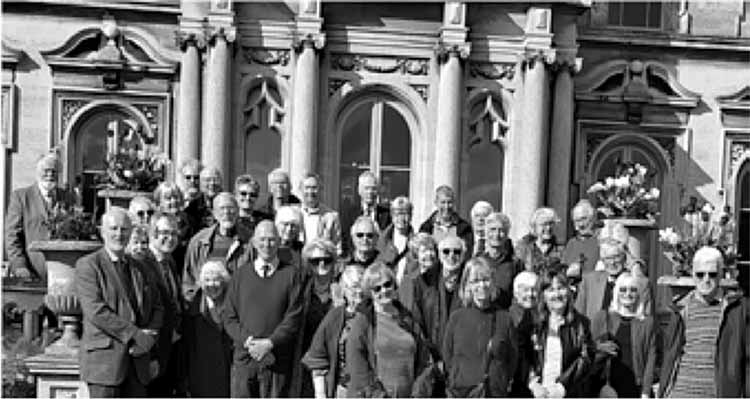Events during Spring 2023
The Rosalys Coope Lecture: ‘Findings at Greasley Castle’, 11th February 2023
Dr James Wright, Triskele Heritage
James started this lecture by explaining the location of the castle and talked about the research he carried out funded by the Castle Studies Trust. He explained how the castle was built in the 1340s for Nicolas de Cantilupe and gave us a background of the family and the importance of the family in the 14th century. James then explained the site today and expanded on the project which was able to identify what remained of the castle structures within the post -mediaeval farmyard. He explained how the remains of the single courtyard were identified and went on to explain how they discovered part of the west curtain wall, the great hall. James described in detail the analysis revealing a mid- fourteenth century moulded doorway and the access into a screwed passage which opened up to the hall. James then alluded to the formed magnificence of Greasley and showed how they identified timbers in the roof structure of the post-mediaeval barn which were found during the research. He also explained how by the archaeology here on this site it was possible to develop more understanding of mediaeval architecture. James then went on to set the castle in a wider context and how Cantilupe sought to bolster his social position and put the castle and the family's importance in a wider context. He referred to Haddon Hall and how once Greasley may have rivalled Haddon Hall. He pointed out that the great hall at Greasley was proportionate to that at Haddon Hall and other similarities between the two.
There followed a great many questions from the audience, who had fully appreciated the lecture.
Paul Baker
The Norah Witham Lecture: 'Anne Enfield and her artistic work', March 11th 2023
Professor Ross Balzaretti
 Nottingham harvest sketch by Ann Enfield.
Nottingham harvest sketch by Ann Enfield.Ross Balzaretti began his lecture by introducing Anne Enfield (nee Needham) and explaining why, as a Professor of Italian History, he became interested in her and her artwork. In the early 1820s Anne (1801-65) and her family the Needhams who lived in Lenton House (now adjacent to University Park), became friendly with Count Santorre Santarosa, a political refugee from Piemonte in northwest Italy. In 1824 Anne made a drawing of the family with Santarosa in their garden, and we know that other Italian refugees were hosted by them in Nottingham at that time. Trying (unsuccessfully) to track down this drawing (apparently now in the National Risorgimento Museum in Turin), led to discovery of other drawings and watercolours by Anne, many of them of local scenes in and around Nottingham. These show that Anne was, like many women of her class, a considerable amateur artist, whose work should be reappraised. A surviving album contains pencil sketches of the environs of Lenton House, Wilford church, Clifton and haymaking in the country thereabouts, all dated to 1826-28. These views can be located using a combination of archival documents, maps and fieldwork, as was recently done for northwest Italy in a book which Ross has recently completed with Pietro Piana and Charles Watkins (Rediscovering Lost Landscapes. Topographical Art in North-West Italy, 1800-1920), using drawings and paintings made by amateur British artists like Anne who toured this part of Italy. Anne herself did travel abroad to France and Belgium, and made internal tours of Britain, visiting Malvern, Varteg in Monmouthshire and elsewhere. Some of her relatives also holidayed in Florence.
During her lifetime, Anne developed a considerable local reputation for her work. In 1854 she issued a series of six lithographs including views of the Trent at Wilford, Wilford Church, Wilford Ferry boat, the windmills on the Forest, the Castle and Bridlesmith Gate. These were sold for the benefit of the new Midland Institute for the Blind. In Old and New Nottingham, 1853, W.H. Wylie described Anne as an artist ‘whose landscapes are characterised by truthfulness to nature and a delicate perception of the peculiar feeling of the scenes’. A watercolour of Nottingham Castle painted in 1860 shows a group of well-dressed men and women being shown the ruined ducal palace. Also in the painting are five members of the Robin Hood Rifles in their dark green uniforms suggesting that the image may be related to the Bazaar held at Castle ground for the Rifle fund on June 10th that year.
The lecture concluded with comparisons between Anne’s work and that of other talented local women including Henrietta Elizabeth Howard, who lived at Mapperley Hall in Mapperley Park, and Emma Wilmot of Worksop. The abiding message from Ross’s excellent and well-illustrated lecture was that the technical precision and topographical specificity of such ‘amateur’ work is particularly valuable to historians trying to reconstruct the landscapes of early nineteenth-century Nottinghamshire.
Richard Gaunt
AGM and Spring Meeting at Flintham Hall
The AGM and Spring Meeting of the Thoroton Society was held at the Church and at Flintham Hall on Saturday 29th April.The AGM and Spring Meeting of the Thoroton Society was held in St Augustine’s church at Flintham on Saturday 29th April. The venue for most of the day was Flintham Hall, at the kind invitation of Sir Robert Thoroton Hildyard, but the AGM was held in the church as it offered a larger space and seating. The meeting was attended by 44 members of the Society. Richard Gaunt, the Chair, addressed the meeting and thanked the Rector, Rev Ruth Coleby, for permission to use the church and Sir Robert for hosting us at Flintham Hall. After completion of the formalities of the AGM, our President, Adrian Henstock, gave one of his usual interesting talks (see page 11) On this 400th anniversary year of the birth of Dr Robert Thoroton, Adrian chose the remarkable fact that Dr Thoroton, his ancestors, his siblings and their descendants, have all lived in this small area of Nottinghamshire for at least 1000 years. This was followed by a talk by Sue Clayton on the history of the church and its shared history with the Hildyard family, as illustrated by the hatchments on the interior church walls. Sir Robert then gave a brief address, with more information on the hatchments, and invited everyone over to the Hall. A sumptuous tea was served in the Hall, and afterwards members were given tours of the house and grounds by Sir Robert and other members of the family who were present. Although it had rained at one point in the afternoon, by the time we left the church and moved to the Hall and grounds, the weather was good and we were able to enjoy the park and gardens, as well as the inside of the Hall.
Rosemary Muge
Presidential speech before the Thoroton Society AGM
As is usual on these occasions I have chosen a slightly off beat aspect of the subject to talk about. I thought it remarkable that Dr Thoroton’s ancestors, his siblings and their descendants have all lived in this small area of Nottinghamshire for at least 1000 years. This tight group of adjoining villages on the edge of the Vale of Belvoir comprises Thoroton, Screveton (originally pronounced Screeton) Flintham, Scarrington and district. I have tried to trace the family’s movements within this area over the centuries. The family derives its surname from the village of Thoroton - originally ‘Thurve-ton’ - a Viking name meaning ‘Thurfrith’s farm’ - and they may well have been of Viking descent. Documents dating from the early 1400s show that the family were ‘yeomen’ - small land-owners rather than tenants of a great estate, whose independent status made them liable to serve on juries for Coroners Inquests and Probate Inquests (called Inquisitions Post Mortem). For example Richard Thoroton of ’Skreton’ was on the probate jury for the deceased William Deyncourt held at Bingham in 1422, and John Thoroton of Thoroton on a similar jury for Thomas Mackworth in 1439. They inherited further property through a marriage with the Morin family - who were of Norman descent - in c. 1516. The Thorotons sold their property in Thoroton and the Morins’s house in Car Colston became their main seat until it was demolished by Dr Thoroton in 1666 when he built a new house adjacent. The doctor was the last of a line of five Roberts as he had no male heirs to carry on his name. A three-generation pedigree written by him in 1663 shows most of his siblings, aunts and uncles intermarrying with local families, two of his aunts having married clergymen. However other brothers moved to London where his younger brother Thomas became a wealthy corn chandler. In 1685 - seven years after the doctor’s death, he purchased the Kirkton estate in Screveton parish, which included an ancient mansion next to the church in the hamlet of Kirkton. However during the 18th Century the Thorotons seem to have rarely lived there, being occupied as London merchants, barristers or military officers. In the meantime the Doctor’s two daughters had both married. Elizabeth was married in 1672 to John Turner, a wealthy self-made coal and lead mine magnate from Swanwick in Derbyshire, whilst the next year Anne was married to Philip Sherard of Whissendine, Rutland, a grandson of William, Baron Leitrim in the Peerage of Ireland. Ultimately both lines ran out of heirs and so ownership of the estates reverted to another Thomas Thoroton, who in 1789 sold all the Turner’s mineral interests in the Alfreton area for £16,100. This money was used to buy the small Flintham House as a new seat for the family. Additional funds were raised when in 1815 Thomas married the niece and heiress of Sir Robert D'Arcy Hildyard of Winestead in Yorkshire subject to Thomas taking the surname Hildyard, a very common practice at this period. Since that time the name Thoroton has been held as a second name for all direct descendants. Thomas began by making alterations to the house, and subsequent reconstructions were added throughout the century by the Hildyard owners, employing architects such as Lewis Wyatt and T C Hine to create the present Flintham Hall.
Adrian Henstock
Adrian ended his speech with a tribute to a former President of the Society, Myles Thoroton Hildyard, who held the office for over 40 years until his death in 2005. He had lived at Flintham. He had lived at Flintham Hall, and was very proud of his Thoroton ancestors.
Visit to Flintham Hall
 The Thoroton insignia on the top of one of the front door porch arches (photo: Paul Baker)
The Thoroton insignia on the top of one of the front door porch arches (photo: Paul Baker)These tours included a history of the house from the 10th century and particular details of Hall and the estate from its purchase by Colonel Thomas Thoroton in 1789 up to the present day. This included a full description of Lewis Wyatt’s engagement in the 1820’s to enlarge the house, with a focus on the library with the bedrooms above and a conservatory. It was explained however that in the mid and late 19th century Thomas Blackborne Hildyard employed Thomas Chambers Hine, the Nottingham based designer of commercial buildings, and Sir Robert explained and showed us how Hine transformed the Hall over five years and provided the two ‘must haves’ of country house designs, the Italianate styling and Crystal Palace type conservatory. The guided groups of Thoroton members were given many more details about the Hall, the Gardens and the Estate and we can only thank Sir Robert and all the family involved in providing us all with a very memorable Spring Meeting following the Society’s AGM.
 Some of the Thoroton members who attended, with Sir Robert Thoroton Hildyard.
Some of the Thoroton members who attended, with Sir Robert Thoroton Hildyard.Paul Baker